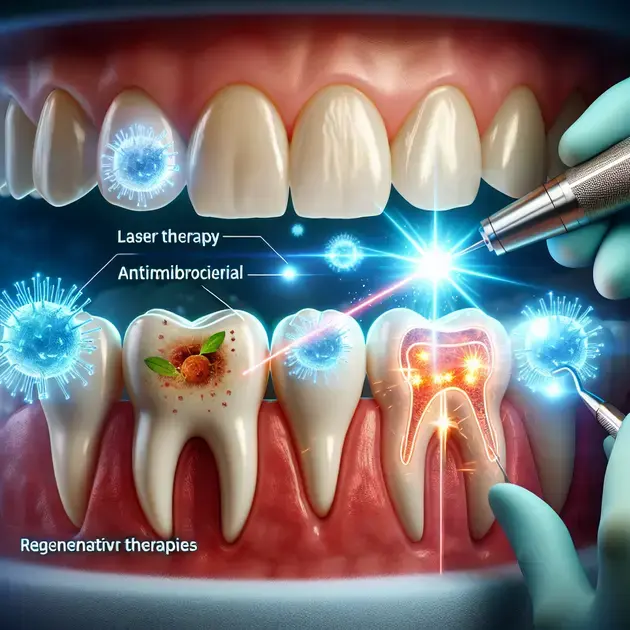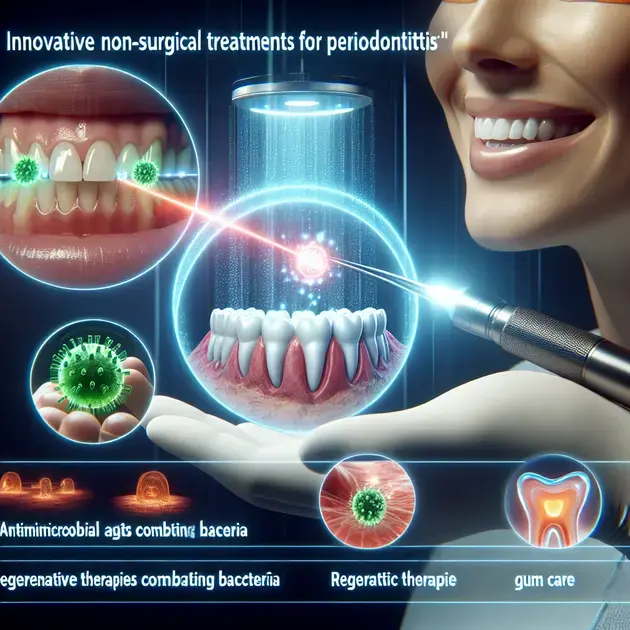Are you looking for an effective medication to treat Periodontitis? Look no further! In this comprehensive guide, we will explore the best treatment options available to combat this common dental issue.
With advancements in dental research and technology, there are more effective medications than ever before to help manage and treat Periodontitis. From antimicrobial mouth rinses to antibiotics and surgical interventions, we will cover everything you need to know to make informed decisions about your oral health.

Choosing the Right Treatment Plan
When it comes to choosing the right treatment plan for your specific health condition, it’s essential to consider various factors to ensure the best outcome. Here is a step-by-step guide to help you make an informed decision:
Evaluate Your Health Condition
The first step in choosing the right treatment plan is to evaluate your health condition carefully. Consult with your healthcare provider to understand the diagnosis, severity of the condition, and any specific requirements for treatment.
Research Treatment Options
Once you have a clear understanding of your health condition, research different treatment options available. Look for reputable sources such as medical websites, peer-reviewed journals, or healthcare apps like WebMD or Mayo Clinic app to gather information on potential treatments.
Consult with Specialists
Seek advice from specialists in the field related to your health condition. They can provide valuable insights into the pros and cons of various treatment options and help you make an informed decision. You can use telemedicine platforms like Doctor On Demand or Amwell to consult with specialists remotely.
Weigh the Pros and Cons
Consider the pros and cons of each treatment option based on factors such as effectiveness, potential side effects, cost, and convenience. Utilize health-focused apps like Healthline or Drugs.com to compare different treatments and their associated benefits and risks.
Create a Treatment Plan
Based on your research and consultations with healthcare providers, create a comprehensive treatment plan that aligns with your health goals and preferences. Use apps like MyTherapy or Mango Health to set reminders for medications or appointments to ensure adherence to the treatment plan.
The Power of Antimicrobial Mouth Rinses
Antimicrobial mouth rinses play a crucial role in maintaining oral hygiene and preventing dental issues. Understanding the power of these rinses can help you make informed decisions about your oral care. Here’s a detailed guide on the benefits and usage of antimicrobial mouth rinses:
Benefits of Antimicrobial Mouth Rinses
Antimicrobial mouth rinses contain active ingredients that target and kill harmful bacteria in the mouth, reducing plaque buildup and the risk of gum disease and cavities. They also freshen breath and promote overall oral health.
Choosing the Right Antimicrobial Mouth Rinse
When selecting an antimicrobial mouth rinse, look for products that are ADA-approved and contain ingredients like chlorhexidine or essential oils. Consult with your dentist to determine the most suitable rinse for your specific oral health needs.
Usage Instructions
To reap the benefits of antimicrobial mouth rinses, follow the usage instructions provided on the product label. Generally, you should rinse with the recommended amount of mouthwash for the specified duration, usually 30 seconds to 1 minute, after brushing your teeth.
Incorporate into Your Oral Care Routine
Integrate antimicrobial mouth rinses into your daily oral care routine for optimal results. Use the rinse after brushing and flossing your teeth to ensure thorough cleaning and protection against oral bacteria.
Monitor Oral Health Improvements
Regularly visit your dentist for check-ups to monitor improvements in your oral health after incorporating antimicrobial mouth rinses into your routine. Your dentist can assess the effectiveness of the rinse and make recommendations for adjustments if needed.
Surgical Interventions: What You Need to Know
When considering surgical interventions for a medical condition, thorough knowledge and preparation are essential to ensure a successful outcome. Here’s a guide to help you understand what you need to know before undergoing surgical treatment:
Educate Yourself About the Procedure
Prior to undergoing surgery, educate yourself about the procedure, including the purpose, potential risks, and expected outcomes. Use reputable medical websites like Healthgrades or the American College of Surgeons website to gather information.
Consult with Your Healthcare Team
Discuss the surgical intervention with your healthcare team, including your primary care physician, surgeon, and any specialists involved in your care. Ask questions, address any concerns, and ensure you have a clear understanding of the treatment plan.
Prepare Mentally and Physically
Prepare yourself mentally and physically for the surgery by following pre-operative guidelines provided by your healthcare team. Use meditation apps like Headspace or Calm to manage anxiety and stress levels before the procedure.
Arrange for Post-Surgery Care
Prior to undergoing surgery, make arrangements for post-surgery care and recovery assistance. Enlist the help of family members or caregivers, and utilize platforms like CareZone to organize medication schedules and recovery tasks.
Follow Up with Your Healthcare Team
After the surgical intervention, adhere to post-operative instructions provided by your healthcare team. Attend follow-up appointments, monitor your recovery progress, and communicate any concerns or unexpected symptoms to your healthcare provider promptly.

Sure, here is how you can structure the content for each subtopic:
**Maximizing the Benefits of Minimally Invasive Procedures**
Maximizing the Benefits of Minimally Invasive Procedures
Minimally invasive procedures have revolutionized the field of medicine by offering patients effective treatments with shorter recovery times and fewer complications. One key way to maximize the benefits of these procedures is through proper pre-operative planning. This involves thorough assessments of the patient’s medical history, current medications, and overall health status to ensure the procedure is tailored to their specific needs.
Another important aspect is post-operative care. Following the surgeon’s instructions meticulously can significantly impact the success of the procedure. This may include taking prescribed medications, attending follow-up appointments, and adhering to activity restrictions. By following these guidelines, patients can experience faster healing and better outcomes.
Furthermore, staying informed about the latest advancements in minimally invasive techniques is crucial for maximizing benefits. Surgeons who regularly undergo training to learn new procedures and technologies can offer patients cutting-edge treatments that optimize results. Patients should feel empowered to ask their healthcare providers about these innovative options.
Additionally, maintaining a healthy lifestyle can enhance the benefits of minimally invasive procedures. Eating a balanced diet, staying physically active, and avoiding harmful habits like smoking can promote healing and reduce the risk of complications. Patients who prioritize their overall well-being can improve their recovery process and long-term results.
In conclusion, by focusing on pre-operative planning, post-operative care, staying informed about advancements, and leading a healthy lifestyle, patients can truly maximize the benefits of minimally invasive procedures and achieve optimal outcomes.
**The Impact of Lifestyle Choices on Periodontitis Treatment**
The Impact of Lifestyle Choices on Periodontitis Treatment
Lifestyle choices play a significant role in the treatment and prevention of periodontitis, a common and serious gum disease. One key lifestyle factor that can impact periodontitis treatment is diet. Consuming a balanced diet rich in nutrients like vitamins C and D can support gum health and facilitate the healing process. Conversely, a diet high in sugar and processed foods can exacerbate inflammation and contribute to the progression of periodontitis.
Another crucial aspect is oral hygiene practices. Regular brushing, flossing, and dental check-ups are essential for managing periodontitis. Patients with this condition should follow their dentist’s recommendations diligently to control plaque build-up and prevent further damage to the gums and supporting structures.
Moreover, smoking is a significant lifestyle factor that negatively affects periodontitis treatment. Tobacco use hinders the body’s ability to fight infection and slows down the healing process. Quitting smoking can substantially improve the effectiveness of periodontal treatments and increase the chances of successful outcomes.
Furthermore, stress management techniques can also impact periodontitis treatment. Chronic stress can weaken the immune system and exacerbate inflammation, making it harder for the body to combat gum disease. Engaging in activities like exercise, meditation, and relaxation exercises can help reduce stress levels and support periodontal health.
In summary, making positive lifestyle choices such as maintaining a healthy diet, practicing good oral hygiene, quitting smoking, and managing stress can have a profound impact on the success of periodontitis treatment. Patients who prioritize these aspects can improve their overall oral health and enhance the effectiveness of professional interventions.
**Innovations in Non-Surgical Approaches to Combat Periodontitis**
Innovations in Non-Surgical Approaches to Combat Periodontitis
Advancements in non-surgical approaches have transformed the management of periodontitis, offering patients minimally invasive options that effectively target gum disease. One innovative technique is laser therapy, which uses focused light energy to remove diseased tissue and bacteria from the gums. This approach is less invasive than traditional surgery and promotes faster healing with reduced discomfort.
Another emerging non-surgical approach is the use of antimicrobial agents to control periodontal infections. These agents can be applied locally or systemically to target the bacteria responsible for gum disease. By utilizing targeted antimicrobial treatments, dentists can effectively combat periodontitis and prevent its progression without the need for surgery.
Additionally, regenerative therapies represent a promising innovation in non-surgical periodontal treatment. These techniques involve using biocompatible materials and growth factors to stimulate the body’s natural healing processes and regenerate damaged tissues. Regenerative therapies can help restore the health of the gums and supporting bone, leading to improved periodontal outcomes.
Furthermore, telemedicine and virtual consultations have become increasingly popular in non-surgical periodontal care, especially in light of the COVID-19 pandemic. Patients can now receive remote evaluations, treatment planning, and follow-up care from the comfort of their homes, enhancing accessibility and convenience while maintaining the quality of care.
In conclusion, innovations in non-surgical approaches such as laser therapy, antimicrobial agents, regenerative therapies, and telemedicine are revolutionizing the treatment of periodontitis. These advancements offer patients effective, minimally invasive options to combat gum disease and preserve their oral health with enhanced convenience and comfort.
**
Conclusion
**
In conclusion, maximizing the benefits of minimally invasive procedures involves a comprehensive approach that includes pre-operative planning, post-operative care, staying informed about advancements, and maintaining a healthy lifestyle. By focusing on these aspects, patients can optimize the outcomes of their treatments and experience faster healing with fewer complications. Proper pre-operative planning ensures that procedures are tailored to individual needs, while meticulous post-operative care and adherence to guidelines lead to better results.
Similarly, the impact of lifestyle choices on periodontitis treatment underscores the importance of a balanced diet, excellent oral hygiene practices, smoking cessation, and stress management. These lifestyle factors significantly influence the success of periodontal interventions, emphasizing the need for patients to prioritize their overall well-being to enhance treatment outcomes and improve oral health in the long run.
Furthermore, innovations in non-surgical approaches to combat periodontitis, such as laser therapy, antimicrobial agents, regenerative therapies, and telemedicine, are reshaping the way gum disease is managed. These cutting-edge techniques offer minimally invasive options that effectively target periodontitis, providing patients with convenient and comfortable treatment solutions that promote healing and preserve oral health. Embracing these advancements can lead to improved periodontal outcomes and a better quality of life for individuals dealing with gum disease.



